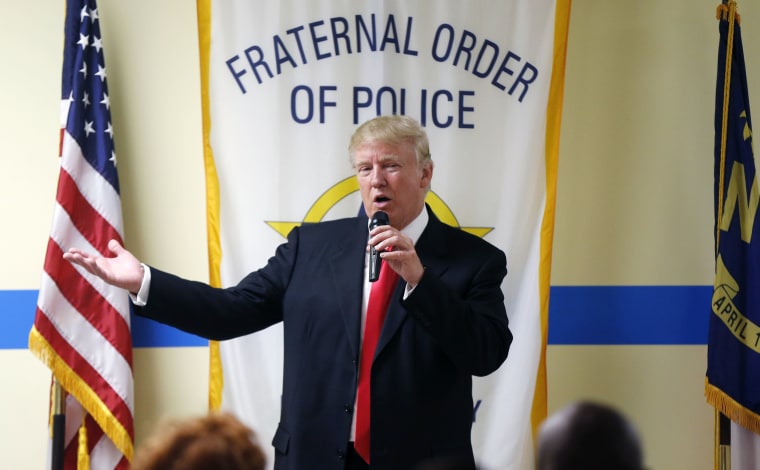Donald Trump is staying true to his tough talk on crime and law enforcement in America's most violent cities, no matter the political costs. In response to the unrest in Charlotte, Trump called for the nationwide adoption of a practice a federal judge called unconstitutional and critics derided as ineffective racial profiling.
During a campaign stop at an African American church in Cleveland and in multiple interviews over the course of the past 24 hours, Trump hailed a policy known as “stop-and-frisk” and offered it as solution to crime-ridden neighborhoods in cities like Chicago. The tactic authorizes police to indiscriminately stop and search any pedestrian for weapons or illegal contraband.
"I think stop-and-frisk, in New York City, it was so incredible the way it worked,” Trump said during a town hall posted by Fox News Host Sean Hannity.
But stop-and-frisk has been fraught with controversy and largely discredited as a way to reduce crime.
Related: Trump Calls for Anti-Crime Agenda Amid Charlotte Unrest
In 2013, after 14 years of litigation a federal judge in New York City ruled the practice unconstitutional. The ruling found it allowed police to turn “a blind eye” on the “racially discriminatory manner” the searches were carried out.
NYPD statistics cited by the ACLU show the stops overwhelmingly targeted young black and Hispanic men in communities of color.
In 2002 the NYPD made 97,296 stops and 82 percent of those stopped, or 80,17, were not charged with any crime.
The practice peaked in 2011 when the cops made 685,724 stop and frisks. Only nine percent of those stopped were white while 87 percent were blacks and Latinos. Most were between the ages of 14 and 24, according to the same report and the vast majority were not charged.
During that time, residents in neighborhoods like Bedford Stuyvesant and the Bronx often described feeling targeted by the police for nothing more than their skin color.
Trump endorsed the controversial policy on Wednesday. The same day he expressed concern for the death of another unarmed black man, this time in Tulsa Oklahoma. He called the situation “sad.” He also blamed the protests in Charlotte, NC on a “lack of spirit” between blacks and whites. He has not acknowledged the tensions stop-and-frisk created between minorities and police.
Jeffery Robinson, deputy director of the ACLU, called the tactic legalized racial profiling.
“There’s no question that stop-and-frisk policies exacerbated tensions between law enforcement and communities of color,” Robinson said.
Trump promises to be the “law and order” candidate but like most of his platform, he’s offered little detail beyond enforcing laws already on the books and supporting police. Stop-and-frisk is the first full-fledged policy he’s advocated to earn that self-given title.
Related: Black Cops at Odds With Fraternal Order of Police Over Trump Endorsement
While Trump sticks to the simplistic message that got him the nomination, Hillary Clinton is taking a more nuanced approach. The Democrat supports more police training, specifically when it comes to policing underserved minority communities. She wants implicit bias training which helps officers understand inherent bias.
While some form of stop-and-frisk dates back to the 1960s in New York, it wasn't adopted more widely until the 1990s under Mayor Giuliani and Police Commissioner William Bratton. Giuliani is now a Trump advisor and surrogate. In the 2000s the practice came under increased scrutiny under Mayor Bloomberg and Commissioner Ray Kelly.
While both Bloomberg and Kelly called the federal ruling a mistake, Bratton changed his mind over the years. Newly reinstalled as the city’s police commissioner in 2014 under Mayor Bill DeBlasio , Bratton said in a New Yorker article that stop-and-frisk made it harder for officers to best serve minority communities.
Since 2011, the number of stops dramatically decreased as the NYPD re-focused the policy on a small number of individuals responsible for the most crime.
In a statement to NBC News the NYPD called it a “fundamental policing tool, when used appropriately.”
“Critics cried that crime and violence would spike” when stop and frisk was reformed,” said DCPI Assistant Commissioner J Peter Donald.
“The very opposite occurred, as the New York City Police Department exercised precision policing to address the limited pockets of crime.”
The Brennan Center for Justice agrees. Its independent analysis showed “the number of murders fell while the number of stops declined.”
“In fact, the biggest fall in murder rates occurred precisely when the number of stops also fell by a large amount — in 2013.”
But Robinson argues that even when stop-and-frisk isn’t official policy, it’s unofficial practice in police departments around the country.
“It is blanket harassment of an entire community and so it is a policy that not only has constitutional, moral and ethical failings, but practically speaking it does nothing. It’s not effective in making the community safer,” Robinson said.

